Chronic Rheumatoid Arthritis Self-Management Plan: Case Study Analysis
VerifiedAdded on 2021/04/17
|18
|3601
|40
Report
AI Summary
This report focuses on developing a self-management plan for a patient with chronic rheumatoid arthritis, addressing the challenges of managing the condition and related co-morbidities. The introduction emphasizes the significant impact of chronic diseases on patients' lifestyles, defining chronic conditions and highlighting the need for effective management strategies, particularly self-management. The case study introduces Emily, a 78-year-old woman with chronic arthritis, diabetes, and hypertension, detailing her medical and psychosocial history. The report utilizes the Chronic Care Model (CCM) to guide the development of the self-management plan, outlining the model's six key elements: delivery system design, self-management support, decision support, clinical information systems, community resources, and policies. The self-management plan includes goals, strategies, interventions, and evaluation metrics to empower the patient to take ownership of her health needs, perform health promotion activities, and adjust to the illness, ultimately improving her quality of life. The plan incorporates both pharmacological and non-pharmacological interventions and emphasizes the importance of patient involvement in decision-making and problem-solving.

Running head: CHRONIC RHEUMATOID ARTHRITIS SELF MANAGEMENT
Chronic rheumatoid arthritis self management
Name of the student:
Name of the university:
Author note:
Chronic rheumatoid arthritis self management
Name of the student:
Name of the university:
Author note:
Paraphrase This Document
Need a fresh take? Get an instant paraphrase of this document with our AI Paraphraser
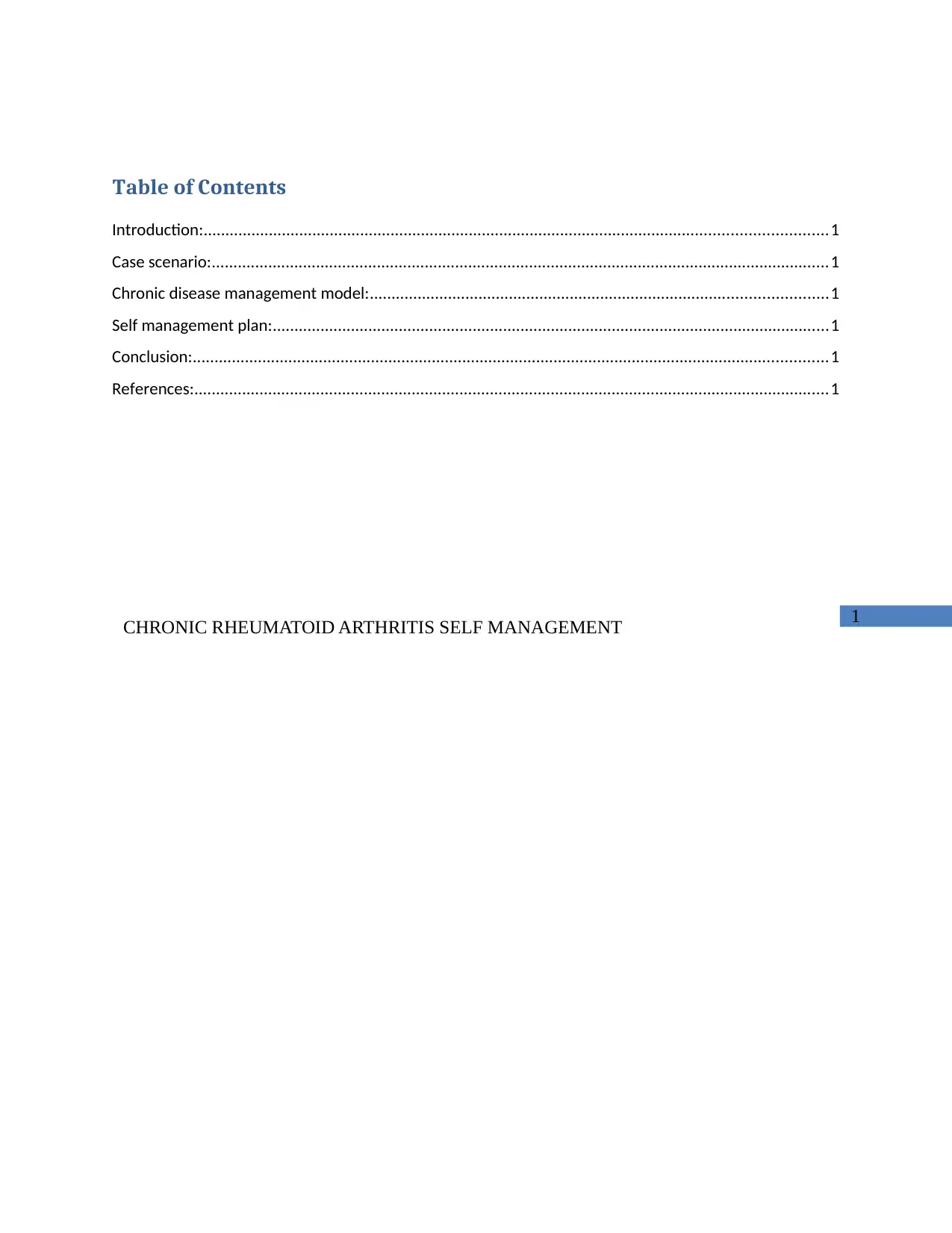
1
CHRONIC RHEUMATOID ARTHRITIS SELF MANAGEMENT
Table of Contents
Introduction:...............................................................................................................................................1
Case scenario:..............................................................................................................................................1
Chronic disease management model:.........................................................................................................1
Self management plan:................................................................................................................................1
Conclusion:..................................................................................................................................................1
References:..................................................................................................................................................1
CHRONIC RHEUMATOID ARTHRITIS SELF MANAGEMENT
Table of Contents
Introduction:...............................................................................................................................................1
Case scenario:..............................................................................................................................................1
Chronic disease management model:.........................................................................................................1
Self management plan:................................................................................................................................1
Conclusion:..................................................................................................................................................1
References:..................................................................................................................................................1
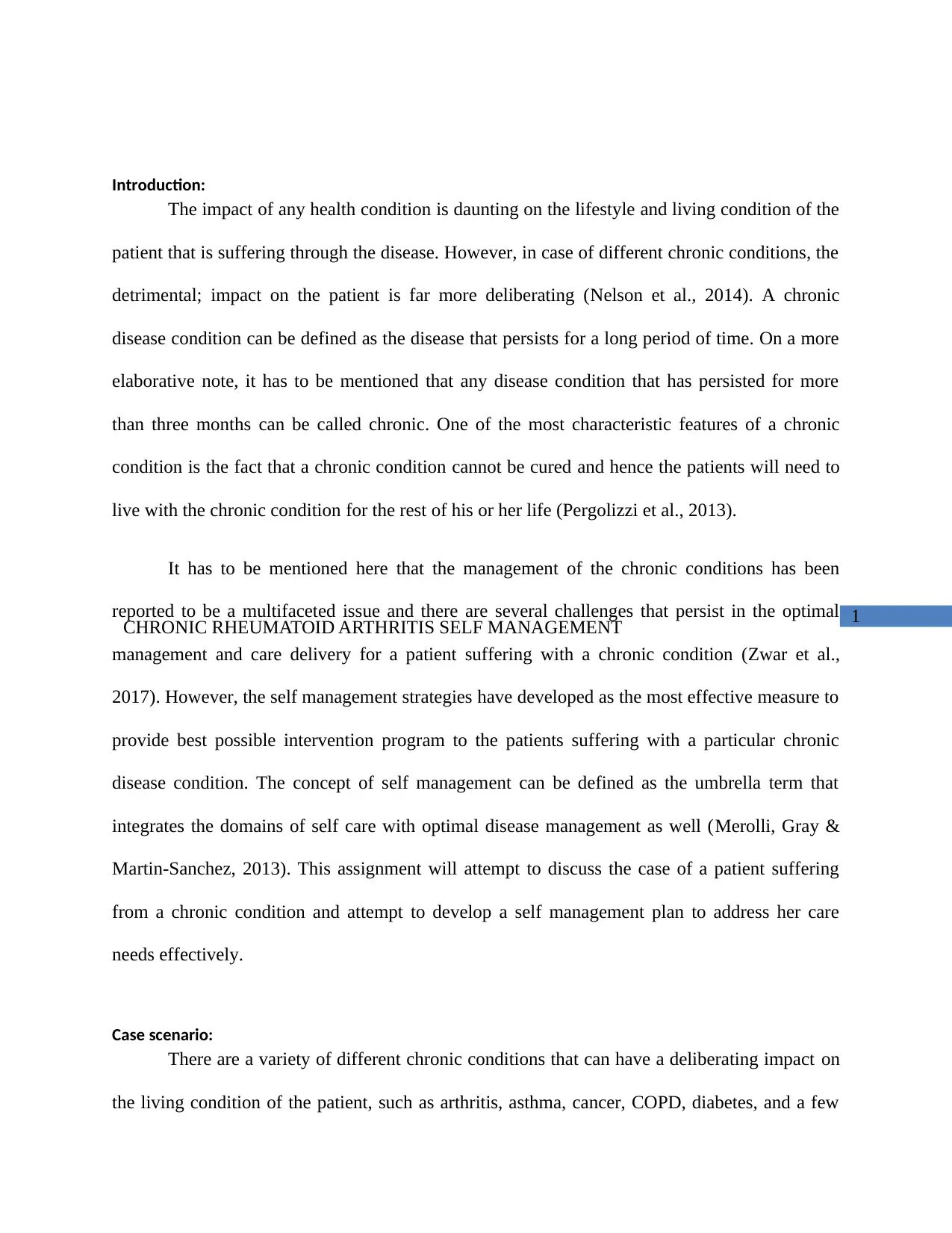
1
CHRONIC RHEUMATOID ARTHRITIS SELF MANAGEMENT
Introduction:
The impact of any health condition is daunting on the lifestyle and living condition of the
patient that is suffering through the disease. However, in case of different chronic conditions, the
detrimental; impact on the patient is far more deliberating (Nelson et al., 2014). A chronic
disease condition can be defined as the disease that persists for a long period of time. On a more
elaborative note, it has to be mentioned that any disease condition that has persisted for more
than three months can be called chronic. One of the most characteristic features of a chronic
condition is the fact that a chronic condition cannot be cured and hence the patients will need to
live with the chronic condition for the rest of his or her life (Pergolizzi et al., 2013).
It has to be mentioned here that the management of the chronic conditions has been
reported to be a multifaceted issue and there are several challenges that persist in the optimal
management and care delivery for a patient suffering with a chronic condition (Zwar et al.,
2017). However, the self management strategies have developed as the most effective measure to
provide best possible intervention program to the patients suffering with a particular chronic
disease condition. The concept of self management can be defined as the umbrella term that
integrates the domains of self care with optimal disease management as well (Merolli, Gray &
Martin-Sanchez, 2013). This assignment will attempt to discuss the case of a patient suffering
from a chronic condition and attempt to develop a self management plan to address her care
needs effectively.
Case scenario:
There are a variety of different chronic conditions that can have a deliberating impact on
the living condition of the patient, such as arthritis, asthma, cancer, COPD, diabetes, and a few
CHRONIC RHEUMATOID ARTHRITIS SELF MANAGEMENT
Introduction:
The impact of any health condition is daunting on the lifestyle and living condition of the
patient that is suffering through the disease. However, in case of different chronic conditions, the
detrimental; impact on the patient is far more deliberating (Nelson et al., 2014). A chronic
disease condition can be defined as the disease that persists for a long period of time. On a more
elaborative note, it has to be mentioned that any disease condition that has persisted for more
than three months can be called chronic. One of the most characteristic features of a chronic
condition is the fact that a chronic condition cannot be cured and hence the patients will need to
live with the chronic condition for the rest of his or her life (Pergolizzi et al., 2013).
It has to be mentioned here that the management of the chronic conditions has been
reported to be a multifaceted issue and there are several challenges that persist in the optimal
management and care delivery for a patient suffering with a chronic condition (Zwar et al.,
2017). However, the self management strategies have developed as the most effective measure to
provide best possible intervention program to the patients suffering with a particular chronic
disease condition. The concept of self management can be defined as the umbrella term that
integrates the domains of self care with optimal disease management as well (Merolli, Gray &
Martin-Sanchez, 2013). This assignment will attempt to discuss the case of a patient suffering
from a chronic condition and attempt to develop a self management plan to address her care
needs effectively.
Case scenario:
There are a variety of different chronic conditions that can have a deliberating impact on
the living condition of the patient, such as arthritis, asthma, cancer, COPD, diabetes, and a few
⊘ This is a preview!⊘
Do you want full access?
Subscribe today to unlock all pages.

Trusted by 1+ million students worldwide
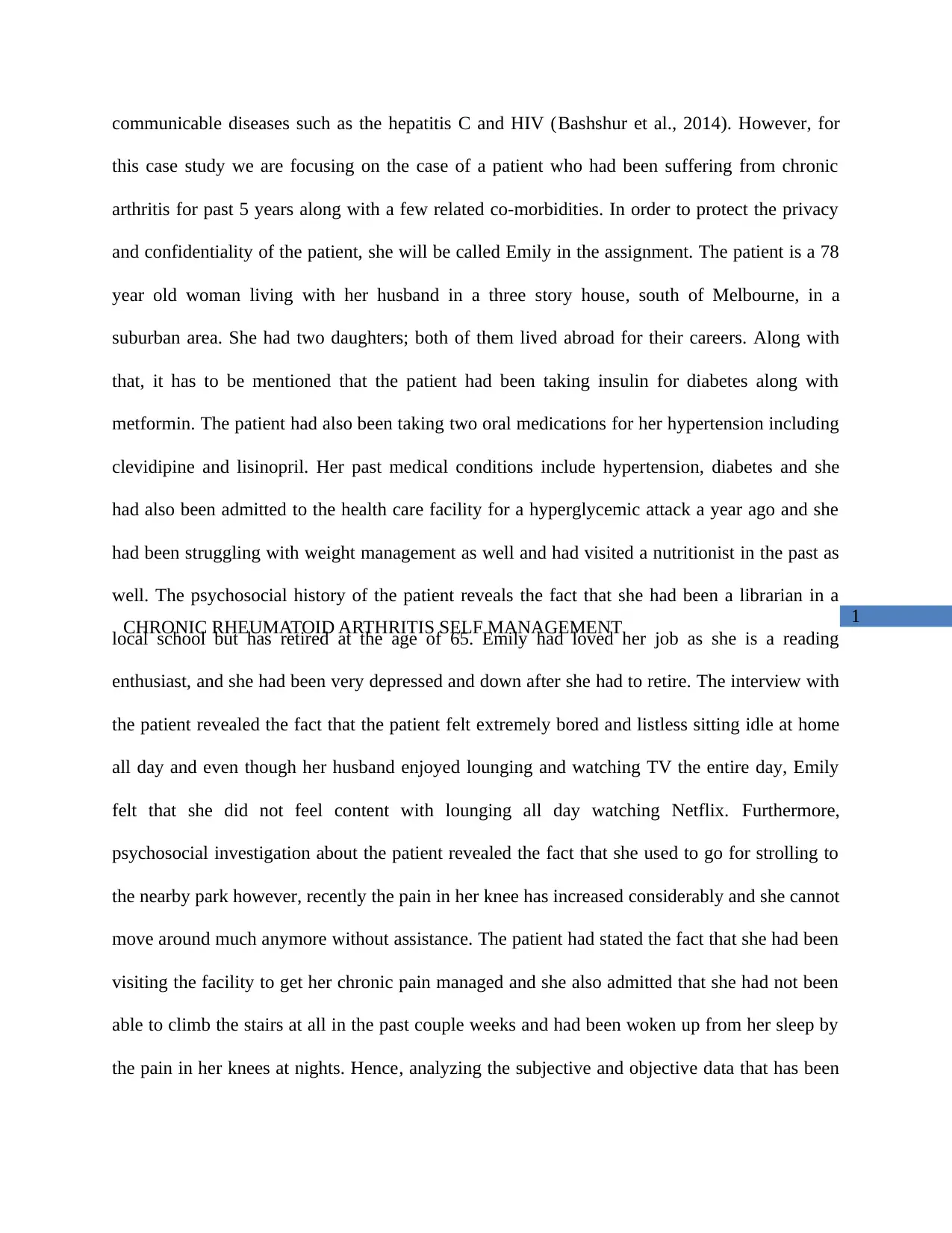
1
CHRONIC RHEUMATOID ARTHRITIS SELF MANAGEMENT
communicable diseases such as the hepatitis C and HIV (Bashshur et al., 2014). However, for
this case study we are focusing on the case of a patient who had been suffering from chronic
arthritis for past 5 years along with a few related co-morbidities. In order to protect the privacy
and confidentiality of the patient, she will be called Emily in the assignment. The patient is a 78
year old woman living with her husband in a three story house, south of Melbourne, in a
suburban area. She had two daughters; both of them lived abroad for their careers. Along with
that, it has to be mentioned that the patient had been taking insulin for diabetes along with
metformin. The patient had also been taking two oral medications for her hypertension including
clevidipine and lisinopril. Her past medical conditions include hypertension, diabetes and she
had also been admitted to the health care facility for a hyperglycemic attack a year ago and she
had been struggling with weight management as well and had visited a nutritionist in the past as
well. The psychosocial history of the patient reveals the fact that she had been a librarian in a
local school but has retired at the age of 65. Emily had loved her job as she is a reading
enthusiast, and she had been very depressed and down after she had to retire. The interview with
the patient revealed the fact that the patient felt extremely bored and listless sitting idle at home
all day and even though her husband enjoyed lounging and watching TV the entire day, Emily
felt that she did not feel content with lounging all day watching Netflix. Furthermore,
psychosocial investigation about the patient revealed the fact that she used to go for strolling to
the nearby park however, recently the pain in her knee has increased considerably and she cannot
move around much anymore without assistance. The patient had stated the fact that she had been
visiting the facility to get her chronic pain managed and she also admitted that she had not been
able to climb the stairs at all in the past couple weeks and had been woken up from her sleep by
the pain in her knees at nights. Hence, analyzing the subjective and objective data that has been
CHRONIC RHEUMATOID ARTHRITIS SELF MANAGEMENT
communicable diseases such as the hepatitis C and HIV (Bashshur et al., 2014). However, for
this case study we are focusing on the case of a patient who had been suffering from chronic
arthritis for past 5 years along with a few related co-morbidities. In order to protect the privacy
and confidentiality of the patient, she will be called Emily in the assignment. The patient is a 78
year old woman living with her husband in a three story house, south of Melbourne, in a
suburban area. She had two daughters; both of them lived abroad for their careers. Along with
that, it has to be mentioned that the patient had been taking insulin for diabetes along with
metformin. The patient had also been taking two oral medications for her hypertension including
clevidipine and lisinopril. Her past medical conditions include hypertension, diabetes and she
had also been admitted to the health care facility for a hyperglycemic attack a year ago and she
had been struggling with weight management as well and had visited a nutritionist in the past as
well. The psychosocial history of the patient reveals the fact that she had been a librarian in a
local school but has retired at the age of 65. Emily had loved her job as she is a reading
enthusiast, and she had been very depressed and down after she had to retire. The interview with
the patient revealed the fact that the patient felt extremely bored and listless sitting idle at home
all day and even though her husband enjoyed lounging and watching TV the entire day, Emily
felt that she did not feel content with lounging all day watching Netflix. Furthermore,
psychosocial investigation about the patient revealed the fact that she used to go for strolling to
the nearby park however, recently the pain in her knee has increased considerably and she cannot
move around much anymore without assistance. The patient had stated the fact that she had been
visiting the facility to get her chronic pain managed and she also admitted that she had not been
able to climb the stairs at all in the past couple weeks and had been woken up from her sleep by
the pain in her knees at nights. Hence, analyzing the subjective and objective data that has been
Paraphrase This Document
Need a fresh take? Get an instant paraphrase of this document with our AI Paraphraser
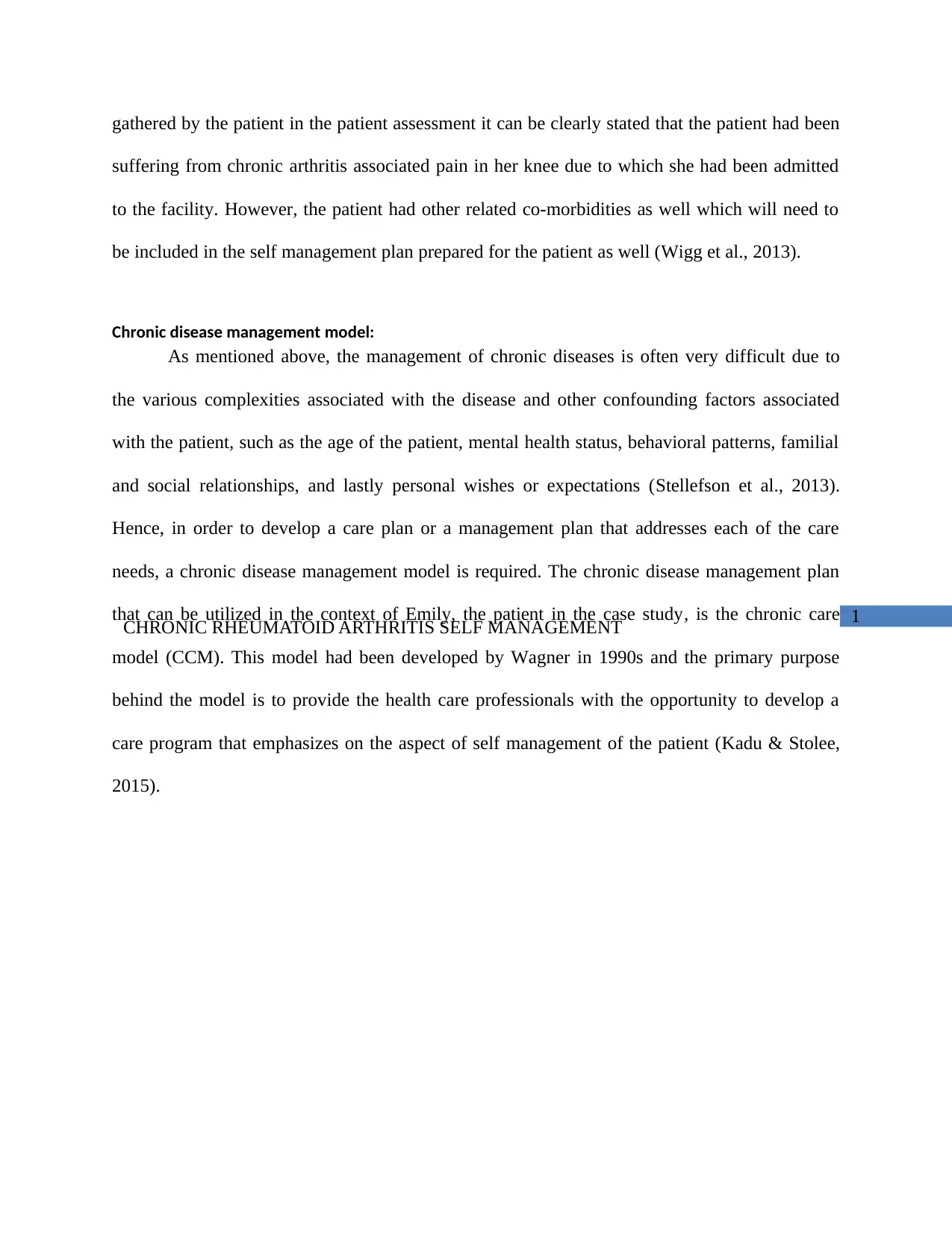
1
CHRONIC RHEUMATOID ARTHRITIS SELF MANAGEMENT
gathered by the patient in the patient assessment it can be clearly stated that the patient had been
suffering from chronic arthritis associated pain in her knee due to which she had been admitted
to the facility. However, the patient had other related co-morbidities as well which will need to
be included in the self management plan prepared for the patient as well (Wigg et al., 2013).
Chronic disease management model:
As mentioned above, the management of chronic diseases is often very difficult due to
the various complexities associated with the disease and other confounding factors associated
with the patient, such as the age of the patient, mental health status, behavioral patterns, familial
and social relationships, and lastly personal wishes or expectations (Stellefson et al., 2013).
Hence, in order to develop a care plan or a management plan that addresses each of the care
needs, a chronic disease management model is required. The chronic disease management plan
that can be utilized in the context of Emily, the patient in the case study, is the chronic care
model (CCM). This model had been developed by Wagner in 1990s and the primary purpose
behind the model is to provide the health care professionals with the opportunity to develop a
care program that emphasizes on the aspect of self management of the patient (Kadu & Stolee,
2015).
CHRONIC RHEUMATOID ARTHRITIS SELF MANAGEMENT
gathered by the patient in the patient assessment it can be clearly stated that the patient had been
suffering from chronic arthritis associated pain in her knee due to which she had been admitted
to the facility. However, the patient had other related co-morbidities as well which will need to
be included in the self management plan prepared for the patient as well (Wigg et al., 2013).
Chronic disease management model:
As mentioned above, the management of chronic diseases is often very difficult due to
the various complexities associated with the disease and other confounding factors associated
with the patient, such as the age of the patient, mental health status, behavioral patterns, familial
and social relationships, and lastly personal wishes or expectations (Stellefson et al., 2013).
Hence, in order to develop a care plan or a management plan that addresses each of the care
needs, a chronic disease management model is required. The chronic disease management plan
that can be utilized in the context of Emily, the patient in the case study, is the chronic care
model (CCM). This model had been developed by Wagner in 1990s and the primary purpose
behind the model is to provide the health care professionals with the opportunity to develop a
care program that emphasizes on the aspect of self management of the patient (Kadu & Stolee,
2015).
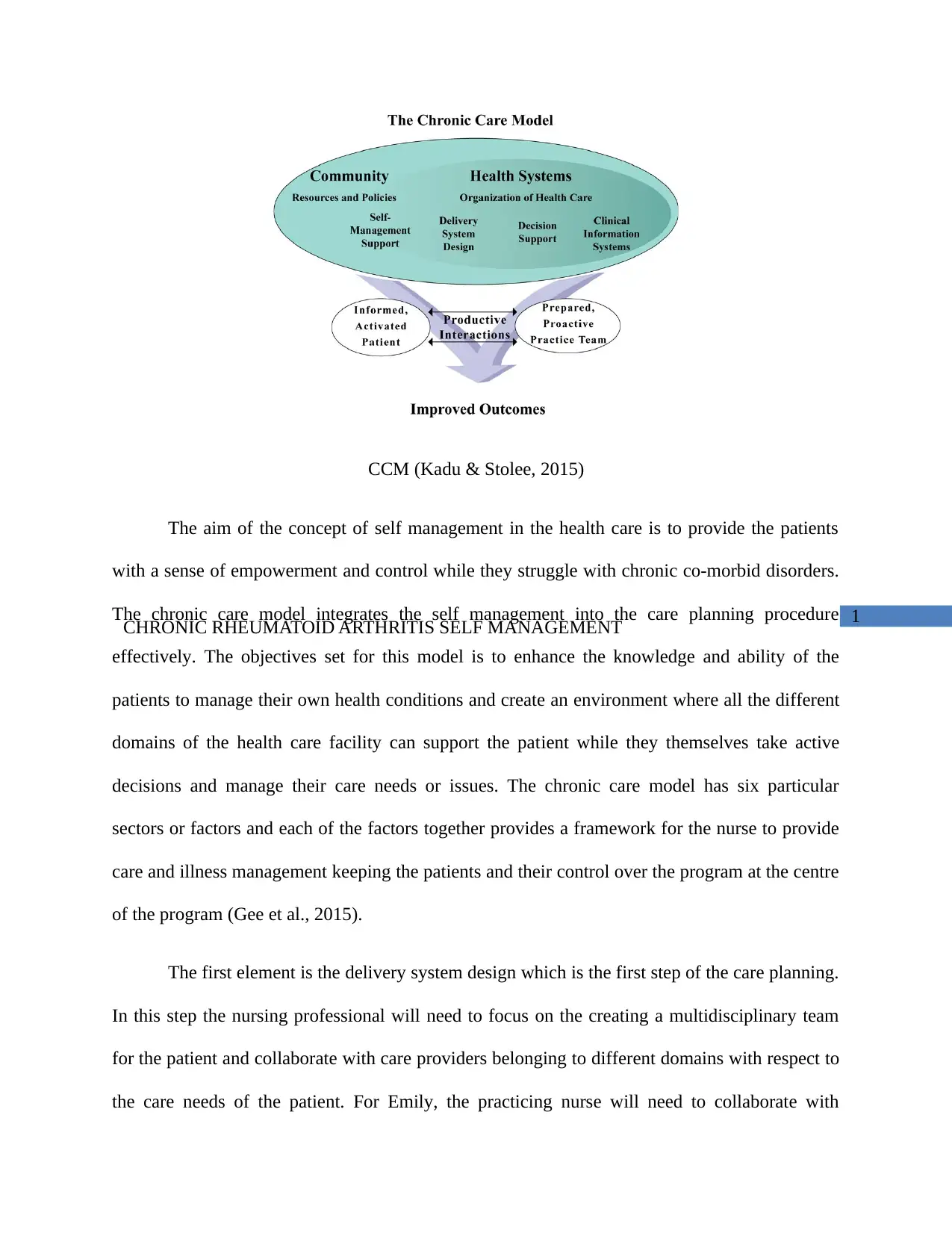
1
CHRONIC RHEUMATOID ARTHRITIS SELF MANAGEMENT
CCM (Kadu & Stolee, 2015)
The aim of the concept of self management in the health care is to provide the patients
with a sense of empowerment and control while they struggle with chronic co-morbid disorders.
The chronic care model integrates the self management into the care planning procedure
effectively. The objectives set for this model is to enhance the knowledge and ability of the
patients to manage their own health conditions and create an environment where all the different
domains of the health care facility can support the patient while they themselves take active
decisions and manage their care needs or issues. The chronic care model has six particular
sectors or factors and each of the factors together provides a framework for the nurse to provide
care and illness management keeping the patients and their control over the program at the centre
of the program (Gee et al., 2015).
The first element is the delivery system design which is the first step of the care planning.
In this step the nursing professional will need to focus on the creating a multidisciplinary team
for the patient and collaborate with care providers belonging to different domains with respect to
the care needs of the patient. For Emily, the practicing nurse will need to collaborate with
CHRONIC RHEUMATOID ARTHRITIS SELF MANAGEMENT
CCM (Kadu & Stolee, 2015)
The aim of the concept of self management in the health care is to provide the patients
with a sense of empowerment and control while they struggle with chronic co-morbid disorders.
The chronic care model integrates the self management into the care planning procedure
effectively. The objectives set for this model is to enhance the knowledge and ability of the
patients to manage their own health conditions and create an environment where all the different
domains of the health care facility can support the patient while they themselves take active
decisions and manage their care needs or issues. The chronic care model has six particular
sectors or factors and each of the factors together provides a framework for the nurse to provide
care and illness management keeping the patients and their control over the program at the centre
of the program (Gee et al., 2015).
The first element is the delivery system design which is the first step of the care planning.
In this step the nursing professional will need to focus on the creating a multidisciplinary team
for the patient and collaborate with care providers belonging to different domains with respect to
the care needs of the patient. For Emily, the practicing nurse will need to collaborate with
⊘ This is a preview!⊘
Do you want full access?
Subscribe today to unlock all pages.

Trusted by 1+ million students worldwide
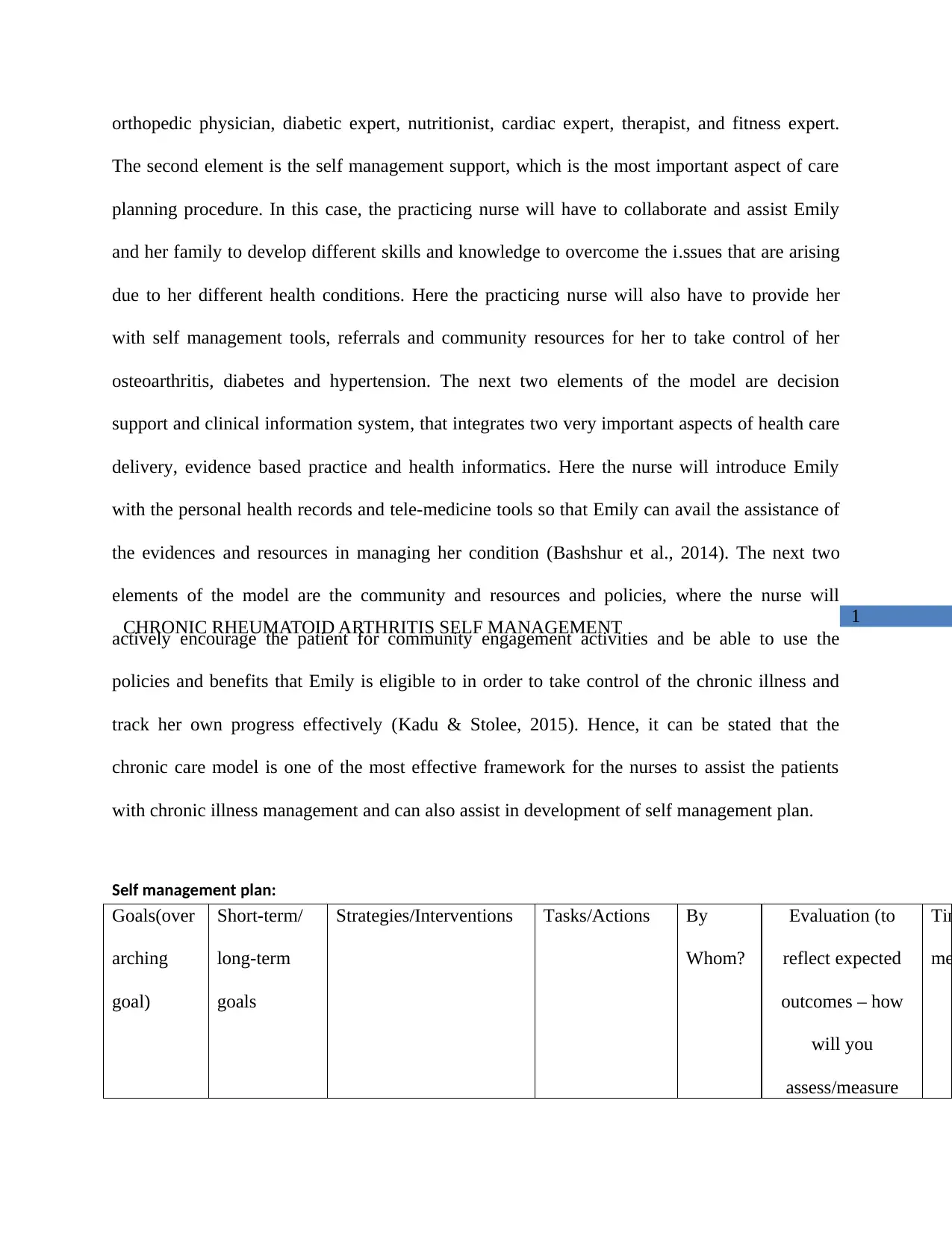
1
CHRONIC RHEUMATOID ARTHRITIS SELF MANAGEMENT
orthopedic physician, diabetic expert, nutritionist, cardiac expert, therapist, and fitness expert.
The second element is the self management support, which is the most important aspect of care
planning procedure. In this case, the practicing nurse will have to collaborate and assist Emily
and her family to develop different skills and knowledge to overcome the i.ssues that are arising
due to her different health conditions. Here the practicing nurse will also have to provide her
with self management tools, referrals and community resources for her to take control of her
osteoarthritis, diabetes and hypertension. The next two elements of the model are decision
support and clinical information system, that integrates two very important aspects of health care
delivery, evidence based practice and health informatics. Here the nurse will introduce Emily
with the personal health records and tele-medicine tools so that Emily can avail the assistance of
the evidences and resources in managing her condition (Bashshur et al., 2014). The next two
elements of the model are the community and resources and policies, where the nurse will
actively encourage the patient for community engagement activities and be able to use the
policies and benefits that Emily is eligible to in order to take control of the chronic illness and
track her own progress effectively (Kadu & Stolee, 2015). Hence, it can be stated that the
chronic care model is one of the most effective framework for the nurses to assist the patients
with chronic illness management and can also assist in development of self management plan.
Self management plan:
Goals(over
arching
goal)
Short-term/
long-term
goals
Strategies/Interventions Tasks/Actions By
Whom?
Evaluation (to
reflect expected
outcomes – how
will you
assess/measure
Tim
me
CHRONIC RHEUMATOID ARTHRITIS SELF MANAGEMENT
orthopedic physician, diabetic expert, nutritionist, cardiac expert, therapist, and fitness expert.
The second element is the self management support, which is the most important aspect of care
planning procedure. In this case, the practicing nurse will have to collaborate and assist Emily
and her family to develop different skills and knowledge to overcome the i.ssues that are arising
due to her different health conditions. Here the practicing nurse will also have to provide her
with self management tools, referrals and community resources for her to take control of her
osteoarthritis, diabetes and hypertension. The next two elements of the model are decision
support and clinical information system, that integrates two very important aspects of health care
delivery, evidence based practice and health informatics. Here the nurse will introduce Emily
with the personal health records and tele-medicine tools so that Emily can avail the assistance of
the evidences and resources in managing her condition (Bashshur et al., 2014). The next two
elements of the model are the community and resources and policies, where the nurse will
actively encourage the patient for community engagement activities and be able to use the
policies and benefits that Emily is eligible to in order to take control of the chronic illness and
track her own progress effectively (Kadu & Stolee, 2015). Hence, it can be stated that the
chronic care model is one of the most effective framework for the nurses to assist the patients
with chronic illness management and can also assist in development of self management plan.
Self management plan:
Goals(over
arching
goal)
Short-term/
long-term
goals
Strategies/Interventions Tasks/Actions By
Whom?
Evaluation (to
reflect expected
outcomes – how
will you
assess/measure
Tim
me
Paraphrase This Document
Need a fresh take? Get an instant paraphrase of this document with our AI Paraphraser
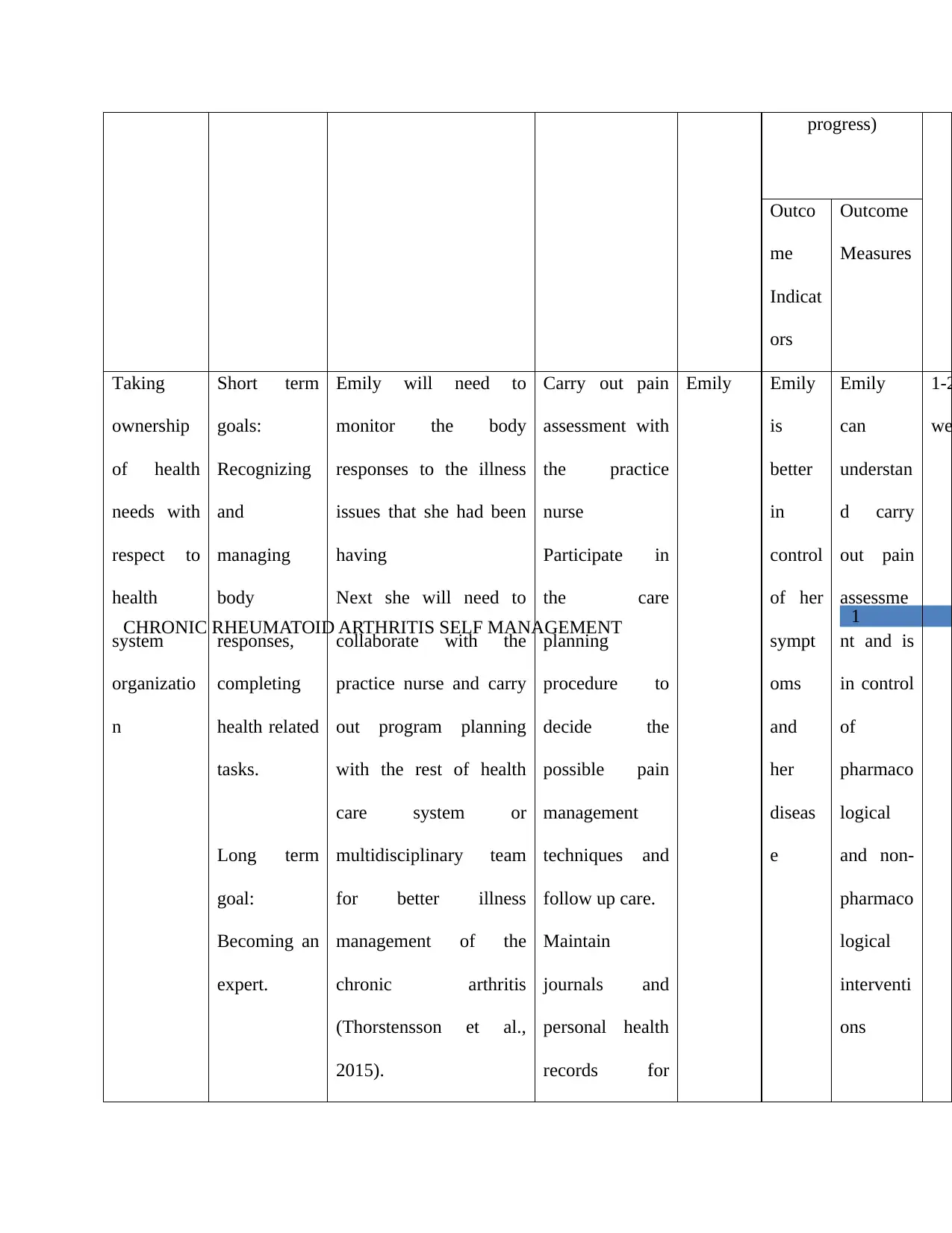
1
CHRONIC RHEUMATOID ARTHRITIS SELF MANAGEMENT
progress)
Outco
me
Indicat
ors
Outcome
Measures
Taking
ownership
of health
needs with
respect to
health
system
organizatio
n
Short term
goals:
Recognizing
and
managing
body
responses,
completing
health related
tasks.
Long term
goal:
Becoming an
expert.
Emily will need to
monitor the body
responses to the illness
issues that she had been
having
Next she will need to
collaborate with the
practice nurse and carry
out program planning
with the rest of health
care system or
multidisciplinary team
for better illness
management of the
chronic arthritis
(Thorstensson et al.,
2015).
Carry out pain
assessment with
the practice
nurse
Participate in
the care
planning
procedure to
decide the
possible pain
management
techniques and
follow up care.
Maintain
journals and
personal health
records for
Emily Emily
is
better
in
control
of her
sympt
oms
and
her
diseas
e
Emily
can
understan
d carry
out pain
assessme
nt and is
in control
of
pharmaco
logical
and non-
pharmaco
logical
interventi
ons
1-2
we
CHRONIC RHEUMATOID ARTHRITIS SELF MANAGEMENT
progress)
Outco
me
Indicat
ors
Outcome
Measures
Taking
ownership
of health
needs with
respect to
health
system
organizatio
n
Short term
goals:
Recognizing
and
managing
body
responses,
completing
health related
tasks.
Long term
goal:
Becoming an
expert.
Emily will need to
monitor the body
responses to the illness
issues that she had been
having
Next she will need to
collaborate with the
practice nurse and carry
out program planning
with the rest of health
care system or
multidisciplinary team
for better illness
management of the
chronic arthritis
(Thorstensson et al.,
2015).
Carry out pain
assessment with
the practice
nurse
Participate in
the care
planning
procedure to
decide the
possible pain
management
techniques and
follow up care.
Maintain
journals and
personal health
records for
Emily Emily
is
better
in
control
of her
sympt
oms
and
her
diseas
e
Emily
can
understan
d carry
out pain
assessme
nt and is
in control
of
pharmaco
logical
and non-
pharmaco
logical
interventi
ons
1-2
we
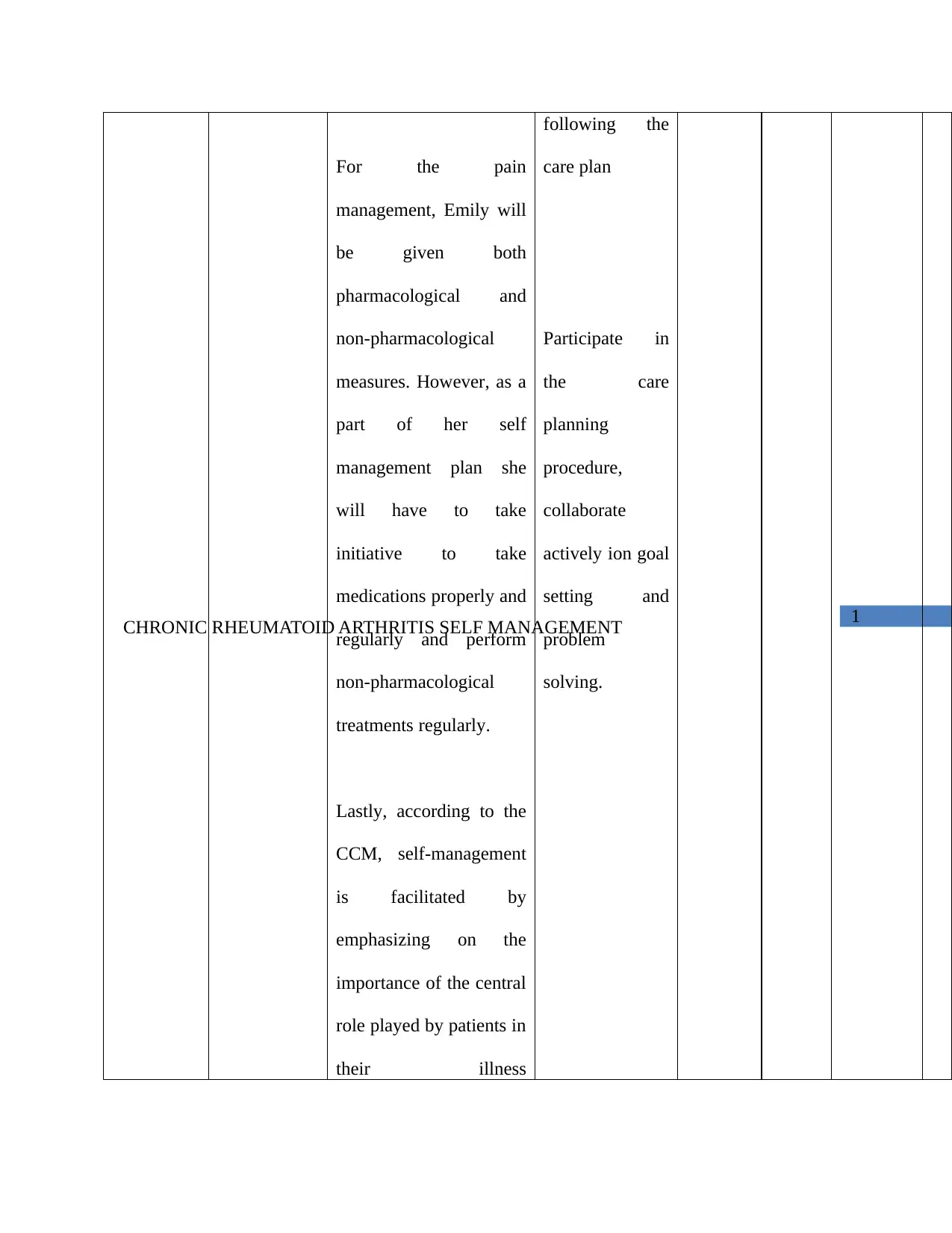
1
CHRONIC RHEUMATOID ARTHRITIS SELF MANAGEMENT
For the pain
management, Emily will
be given both
pharmacological and
non-pharmacological
measures. However, as a
part of her self
management plan she
will have to take
initiative to take
medications properly and
regularly and perform
non-pharmacological
treatments regularly.
Lastly, according to the
CCM, self-management
is facilitated by
emphasizing on the
importance of the central
role played by patients in
their illness
following the
care plan
Participate in
the care
planning
procedure,
collaborate
actively ion goal
setting and
problem
solving.
CHRONIC RHEUMATOID ARTHRITIS SELF MANAGEMENT
For the pain
management, Emily will
be given both
pharmacological and
non-pharmacological
measures. However, as a
part of her self
management plan she
will have to take
initiative to take
medications properly and
regularly and perform
non-pharmacological
treatments regularly.
Lastly, according to the
CCM, self-management
is facilitated by
emphasizing on the
importance of the central
role played by patients in
their illness
following the
care plan
Participate in
the care
planning
procedure,
collaborate
actively ion goal
setting and
problem
solving.
⊘ This is a preview!⊘
Do you want full access?
Subscribe today to unlock all pages.

Trusted by 1+ million students worldwide
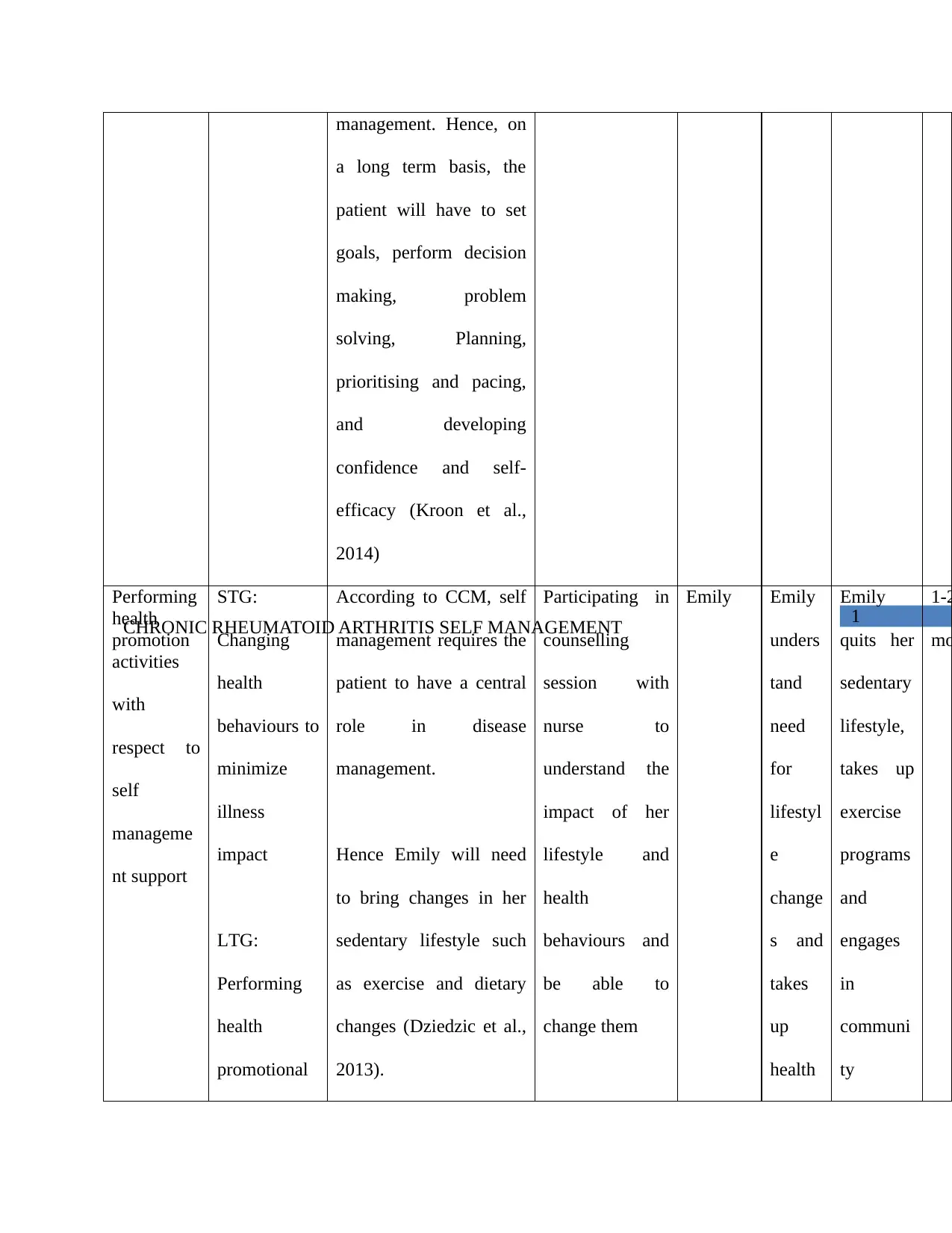
1
CHRONIC RHEUMATOID ARTHRITIS SELF MANAGEMENT
management. Hence, on
a long term basis, the
patient will have to set
goals, perform decision
making, problem
solving, Planning,
prioritising and pacing,
and developing
confidence and self-
efficacy (Kroon et al.,
2014)
Performing
health
promotion
activities
with
respect to
self
manageme
nt support
STG:
Changing
health
behaviours to
minimize
illness
impact
LTG:
Performing
health
promotional
According to CCM, self
management requires the
patient to have a central
role in disease
management.
Hence Emily will need
to bring changes in her
sedentary lifestyle such
as exercise and dietary
changes (Dziedzic et al.,
2013).
Participating in
counselling
session with
nurse to
understand the
impact of her
lifestyle and
health
behaviours and
be able to
change them
Emily Emily
unders
tand
need
for
lifestyl
e
change
s and
takes
up
health
Emily
quits her
sedentary
lifestyle,
takes up
exercise
programs
and
engages
in
communi
ty
1-2
mo
CHRONIC RHEUMATOID ARTHRITIS SELF MANAGEMENT
management. Hence, on
a long term basis, the
patient will have to set
goals, perform decision
making, problem
solving, Planning,
prioritising and pacing,
and developing
confidence and self-
efficacy (Kroon et al.,
2014)
Performing
health
promotion
activities
with
respect to
self
manageme
nt support
STG:
Changing
health
behaviours to
minimize
illness
impact
LTG:
Performing
health
promotional
According to CCM, self
management requires the
patient to have a central
role in disease
management.
Hence Emily will need
to bring changes in her
sedentary lifestyle such
as exercise and dietary
changes (Dziedzic et al.,
2013).
Participating in
counselling
session with
nurse to
understand the
impact of her
lifestyle and
health
behaviours and
be able to
change them
Emily Emily
unders
tand
need
for
lifestyl
e
change
s and
takes
up
health
Emily
quits her
sedentary
lifestyle,
takes up
exercise
programs
and
engages
in
communi
ty
1-2
mo
Paraphrase This Document
Need a fresh take? Get an instant paraphrase of this document with our AI Paraphraser
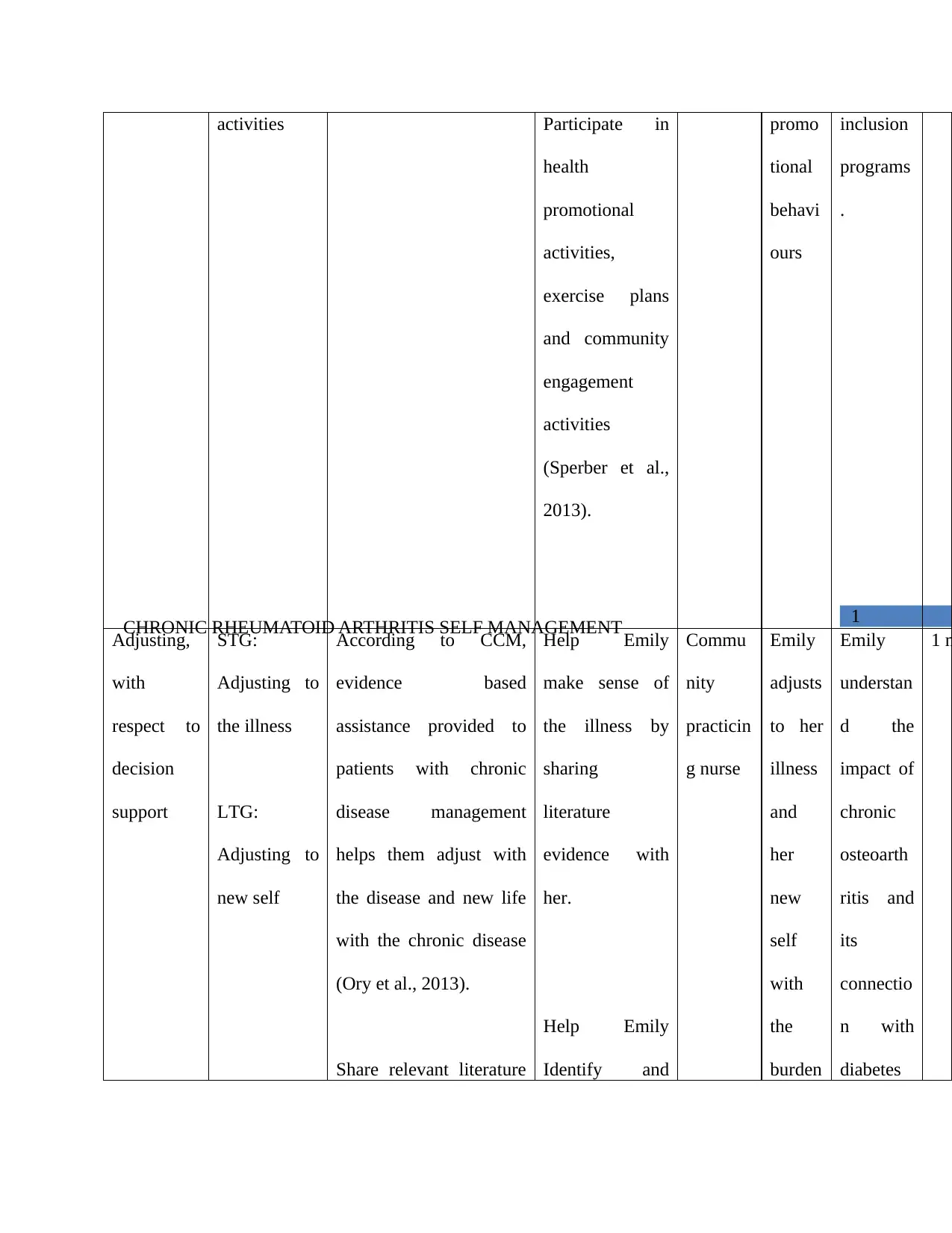
1
CHRONIC RHEUMATOID ARTHRITIS SELF MANAGEMENT
activities Participate in
health
promotional
activities,
exercise plans
and community
engagement
activities
(Sperber et al.,
2013).
promo
tional
behavi
ours
inclusion
programs
.
Adjusting,
with
respect to
decision
support
STG:
Adjusting to
the illness
LTG:
Adjusting to
new self
According to CCM,
evidence based
assistance provided to
patients with chronic
disease management
helps them adjust with
the disease and new life
with the chronic disease
(Ory et al., 2013).
Share relevant literature
Help Emily
make sense of
the illness by
sharing
literature
evidence with
her.
Help Emily
Identify and
Commu
nity
practicin
g nurse
Emily
adjusts
to her
illness
and
her
new
self
with
the
burden
Emily
understan
d the
impact of
chronic
osteoarth
ritis and
its
connectio
n with
diabetes
1 m
CHRONIC RHEUMATOID ARTHRITIS SELF MANAGEMENT
activities Participate in
health
promotional
activities,
exercise plans
and community
engagement
activities
(Sperber et al.,
2013).
promo
tional
behavi
ours
inclusion
programs
.
Adjusting,
with
respect to
decision
support
STG:
Adjusting to
the illness
LTG:
Adjusting to
new self
According to CCM,
evidence based
assistance provided to
patients with chronic
disease management
helps them adjust with
the disease and new life
with the chronic disease
(Ory et al., 2013).
Share relevant literature
Help Emily
make sense of
the illness by
sharing
literature
evidence with
her.
Help Emily
Identify and
Commu
nity
practicin
g nurse
Emily
adjusts
to her
illness
and
her
new
self
with
the
burden
Emily
understan
d the
impact of
chronic
osteoarth
ritis and
its
connectio
n with
diabetes
1 m
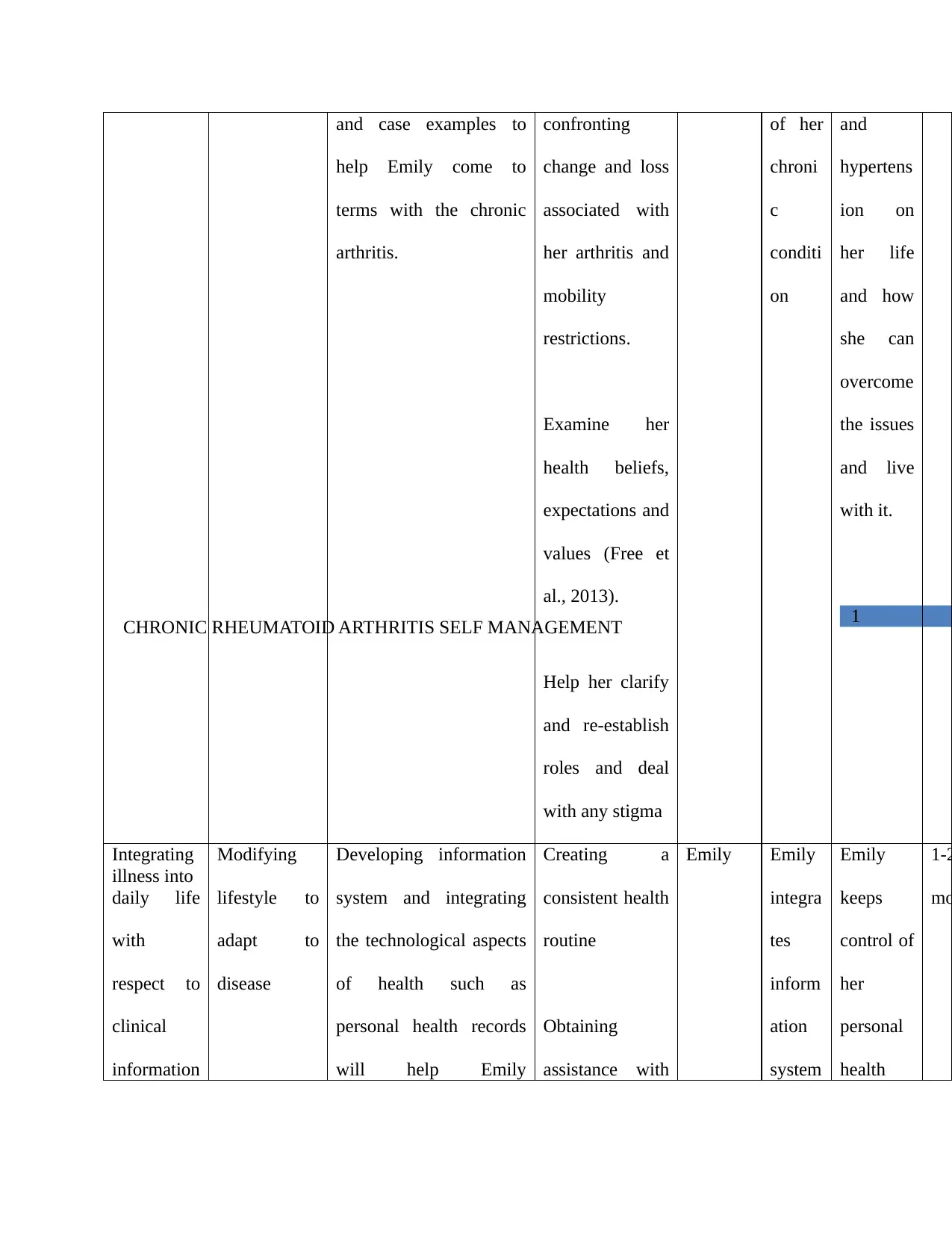
1
CHRONIC RHEUMATOID ARTHRITIS SELF MANAGEMENT
and case examples to
help Emily come to
terms with the chronic
arthritis.
confronting
change and loss
associated with
her arthritis and
mobility
restrictions.
Examine her
health beliefs,
expectations and
values (Free et
al., 2013).
Help her clarify
and re-establish
roles and deal
with any stigma
of her
chroni
c
conditi
on
and
hypertens
ion on
her life
and how
she can
overcome
the issues
and live
with it.
Integrating
illness into
daily life
with
respect to
clinical
information
Modifying
lifestyle to
adapt to
disease
Developing information
system and integrating
the technological aspects
of health such as
personal health records
will help Emily
Creating a
consistent health
routine
Obtaining
assistance with
Emily Emily
integra
tes
inform
ation
system
Emily
keeps
control of
her
personal
health
1-2
mo
CHRONIC RHEUMATOID ARTHRITIS SELF MANAGEMENT
and case examples to
help Emily come to
terms with the chronic
arthritis.
confronting
change and loss
associated with
her arthritis and
mobility
restrictions.
Examine her
health beliefs,
expectations and
values (Free et
al., 2013).
Help her clarify
and re-establish
roles and deal
with any stigma
of her
chroni
c
conditi
on
and
hypertens
ion on
her life
and how
she can
overcome
the issues
and live
with it.
Integrating
illness into
daily life
with
respect to
clinical
information
Modifying
lifestyle to
adapt to
disease
Developing information
system and integrating
the technological aspects
of health such as
personal health records
will help Emily
Creating a
consistent health
routine
Obtaining
assistance with
Emily Emily
integra
tes
inform
ation
system
Emily
keeps
control of
her
personal
health
1-2
mo
⊘ This is a preview!⊘
Do you want full access?
Subscribe today to unlock all pages.

Trusted by 1+ million students worldwide
1 out of 18
Related Documents
Your All-in-One AI-Powered Toolkit for Academic Success.
+13062052269
info@desklib.com
Available 24*7 on WhatsApp / Email
![[object Object]](/_next/static/media/star-bottom.7253800d.svg)
Unlock your academic potential
Copyright © 2020–2025 A2Z Services. All Rights Reserved. Developed and managed by ZUCOL.





